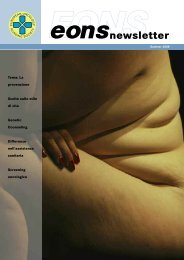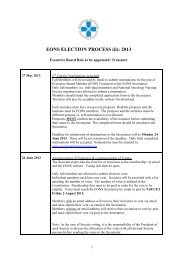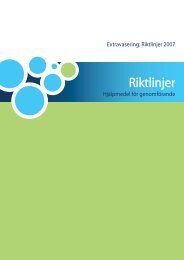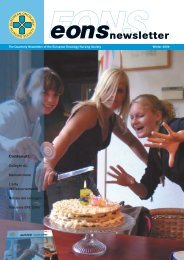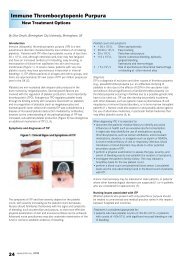Introducing the Extravasation Guidelines - the European Oncology ...
Introducing the Extravasation Guidelines - the European Oncology ...
Introducing the Extravasation Guidelines - the European Oncology ...
Create successful ePaper yourself
Turn your PDF publications into a flip-book with our unique Google optimized e-Paper software.
INTRODUCING THE EXTRAVASATION GUIDELINES:<br />
EONS TOOLKIT POST-SYMPOSIUM REPORT<br />
The importance of using guidelines in clinical practice<br />
– Case study of anthracycline extravasations<br />
H E L EN ROE<br />
Some professionals may consider anthracycline extravasations to be a rare but unfortunate<br />
consequence of administering chemo<strong>the</strong>rapy, so why are guidelines so important<br />
<strong>Guidelines</strong> are essential to ensure<br />
safe practice, provide evidence based<br />
care and increase awareness amongst<br />
professionals enabling <strong>the</strong>m to share<br />
experiences. Until recently, <strong>the</strong>re has not<br />
been any licensed treatment for dealing<br />
with anthracycline extravasations and<br />
teams have used a number of different<br />
non evidence based approaches.<br />
Managing extravasations<br />
Patient details: 47 year old woman with grade 3 breast tumour, had a mastectomy and axillary sampling, and was recommended<br />
to receive FEC100 (5-fluorouracil, Epirubicin and Cyclophosphamide). The anthracycline extravasation happened after cycle 4. The<br />
patient complained of some pain during <strong>the</strong> infusion and <strong>the</strong> nurse noticed a swelling near <strong>the</strong> cannula site. Initial management of<br />
<strong>the</strong> extravasation was performed locally and <strong>the</strong>n <strong>the</strong> patient was referred to <strong>the</strong> regional Plastics Centre where <strong>the</strong> area was ‘flushed’.<br />
Consequences of treatment:<br />
• Patient had to travel to regional plastics centre for surgery<br />
• Invasive treatment<br />
• Painful for <strong>the</strong> patient<br />
• Increase risk of infection for chemo<strong>the</strong>rapy treated patients<br />
• Delay in receiving next cycle of chemo<strong>the</strong>rapy<br />
• Ongoing care needed<br />
Two years on:<br />
• Patient requires antibiotics post procedure<br />
• <strong>Extravasation</strong> area remains visible<br />
• Restricted hand movement<br />
• Skin remains ‘tight’<br />
• Periodically experiences pain in <strong>the</strong> area<br />
• Flare-ups occur<br />
• Permanent reminder



